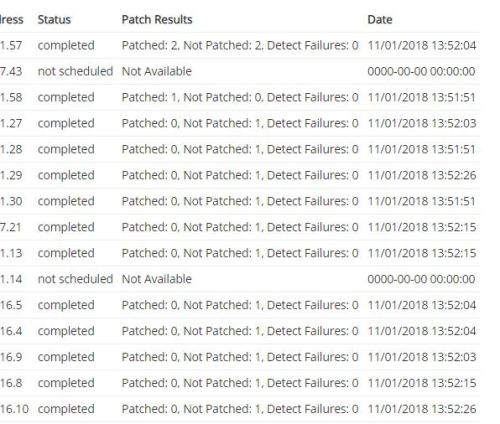Patch Schedule Detect Results
Two part Question........ I have a "Detect Patches" Schedule. (Not newer than 30 days / Not older than 90 days) The run seems to work and completes at 100%. Under the "Show All" section. I see where it logs the results, for example:
My 1st question: What does the "patched 0" mean? Does it mean the server doesn't require any of the patches in the catalog for the schedule? Doesnt make sense to me because wouldnt the server show the patches as "installed"? We have a lot of the same OS servers so this doesnt make sense to me. We have a lot of "not patched" hits but also a lot of these "patched 0" marks and a few "patched X" hits.

| completed | Patched: 2, Not Patched: 2, Detect Failures: 0 | 11/01/2018 13:52:04 |
| completed | Patched: 0, Not Patched: 1, Detect Failures: 0 | 11/01/2018 13:52:03 |
2nd Question: How can you generate a report from this? I can copy and paste the output but would like to be able to generate reports on a schedule.

3 Comments
[ + ] Show comments
-
How many patches are included in your schedule, and how do these results compare to those shown in the inventory for a specific machine? - chucksteel 5 years ago
-
Under the Patch Label we use for the Schedule, it shows there are 60 patches for the label. However when I open it in the Smart Label wizard and "Test", no patches come up. Inventory, l think I understand your question let me see. - lama01 5 years ago
-
Be sure to change the view to individual patches. The catalog defaults to "Applicable Packages" which normally doesn't return what you want. - chucksteel 5 years ago
-
I see the patches now. Right now there are 60 patches in the schedule. I target one server with the patch schedule label and did a detect. The only patches that come up are new patches that wouldn't be included in the schedule. - lama01 5 years ago
Answers (1)
Please log in to answer
Posted by:
chucksteel
5 years ago
Here's a report that shows this information based an a label being assigned to the machines:
SELECT MACHINE.ID, MACHINE.NAME,
PSMS.PATCHED,
PSMS.NOTPATCHED,
PSMS.DETECT_FAILURES,
PSMS.LAST_RUN
FROM PATCHLINK_SCHEDULE_MACHINE_STATUS PSMS
JOIN MACHINE on MACHINE.ID = PSMS.MACHINE_ID
JOIN PATCHLINK_SCHEDULE P on P.ID = PSMS.PATCHLINK_SCHEDULE_ID
JOIN KBSYS.KONDUCTOR_TASK K ON P.KONDUCTOR_TASK_TYPE = K.TYPE and K.KUID = MACHINE.KUID
JOIN MACHINE_LABEL_JT on MACHINE_LABEL_JT.MACHINE_ID = MACHINE.ID
JOIN LABEL on LABEL.ID = MACHINE_LABEL_JT.LABEL_ID
WHERE
LABEL.NAME = "No Patching"
ORDER BY MACHINE.NAME
In our case, we assign a label, "No Patching" to computers that are excluded from our standard patching schedules. You will need to adjust that label in the SQL above.
Comments:
-
Thank u very much for this! Funny though because I still see some servers "Patched" column at 0. I dont understand what that means. Others show various numbers b/w 0=160+. - lama01 5 years ago


